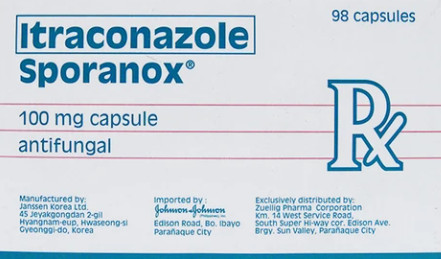
Itraconazole in dermatology
Mechanism of action
- Inhibits the CYP-dependent enzyme lanosterol 14α demethlyase leading to inhibition of the conversion of lanosterol to ergosterol >> fungistatic action.
Indications
- Tinea pedis (moccasin type)/tinea manuum
- adults:200–400 mg/day × 1 week.
- children:3–5 mg/kg/day (maximum 400 mg × 1 week).
- Tinea unguium
- adults:200 mg/day × 6 weeks (or) 200 mg BID × 1 week/month for 2 consecutive months(fingernails) ;200 mg/day × 12 weeks (or) 200 mg BID × 1 week/month for 3–4 consecutive months(toenails).
- children: 5 mg/kg/day (<20 kg), 100 mg/day (20–40 kg), 200 mg/day (40–50 kg), (or) 200 mg BID (>50 kg) × 1 week/month for 2 (fingernails) or 3 (toenails) consecutive months.
- Tinea corporis
- (extensive, adults):200 mg/day × 1 week.
- (extensive, children):3–5 mg/kg/day (maximum 200 mg)× 1 week.
- Tinea capitis
- (adults):5 mg/kg/day (maximum 400 mg) ×4–8 weeks.
- (children): 5 mg/kg/day (maximum 500 mg) ×4–8 weeks.
- Tinea versicolor :
- 200 mg po daily × 5–7 days.
- Single 400 mg dose of itraconazole once monthly for 6 months may be useful as prophylaxis for recurrent tinea versicolor.
- Pityrosporum folliculitis :200 mg/day for 1–3 weeks.
- Blastomycosis : ( mild to moderate non-CNS disease) : 200–400 mg/day.
- Histoplasmosis : (immunocompetent hosts with mild to moderate, stable disease) :200–400 mg/day.
- Aspergillosis :200–400 mg po daily for at least 3 months ( loading dose of 200 mg TID for first 3 days in life-threatening conditions ).
- Majocchi’s granuloma : 200 mg po twice daily for 1 week per month, for 2 pulses.
- Oropharyngeal candidiasis : Swish and swallow 200 mg daily for 1–2 weeks.
- HIV-associated eosinophilic folliculitis :200–400 mg daily.
- Tinea imbricata .
- Recurrent candidiasis : 200 mg BID orally once monthly for 6 months \n
- Chronic mucocutaneous candidiasis.
- Cutaneous sporotrichosis :100–200 mg/day until clinical recovery (at least 3 months).
- Chromoblastomycosis :200–400 mg/day for at least 6 months or until cure.
Monitoring
- Liver function tests:
Side effects
- Gastrointestinal
- Diarrhea (5.6%),dyspepsia(4.3%),abdominal pain (2.4%),nausea (2.6%),flatulence (2.2%).
- Cutaneous
- Rash (5.6%), pruritus(2.8%),urticaria(1.1%), SJS .
- Neurologic
- Headache
- Hepatic
- LFT ≥ 2 × upper limit of normal.
- others
- Fever, edema, hypokalemia, neutropenia (rarely).
Contraindications
- Ventricular dysfunction.
- Hx of cardiac dysfunction (i.e. CHF).
- Use of contraindicated antiarrhythmics/cardiac drugs.
- known hypersensitivity to itraconazole.
- caution if hypersensitive to other azoles.
Interactions
- Itraconazole is contraindicated with dofetilide, levacetylmethadol (levomethadyl).
- Drugs that increase gastric pH, such as proton pump inhibitors, antacids and H2 antihistamines, may reduce the absorption of Itraconazole.
- It also is contraindicated with HMG -CoA-reductase inhibitors such as lovastatin and simvastatin.
- Itraconazole is contraindicated with benzodiazepines midazolam and triazolam.
- It is contraindicated calcium channel blocker nisoldipine, and CYP3A4 ergot alkaloids such as dihydroergotamine, ergometrine (ergonovine), ergotamine and methylergometrine (methylergonovine).
- Phenytoin causes decreased levels of itraconazole.
- Itraconazole reduces cyclosporine metabolism by inhibiting CYP3A4.
- Itraconazole is contraindicated with methadone, disopyramide, dronedarone, quinidine, isavuconazole, irinotecan, ivabradine, lurasidone, pimozide, felodipine, ranolazine, eplerenone, cisapride, naloxegol, lomitapide, avanafil, ticagrelor.
- In patients with varying degrees of renal or hepatic impairment, coadministration of itraconazole with colchicine, fesoterodine, and solifenacin are contraindicated.
Pregnancy and Lactation
- Pregnancy category C.
- Itraconazole is excreted in human milk and should be avoided in lactating patients.
Precautions
- Itraconazole is not recommended with Abnormal LFT.
- It is not recommended also with Active liver disease .
- It is not recommended with hx of liver toxicity with other drugs.
- Itraconazole can cause or exacerbate congestive heart failure.
- Do not use for the treatment of onychomycosis in patients with ventricular dysfunction.
- Monitor for sings and symptoms of CHF.
- Discontinue if signs of neuropathy.
- Transient or permanent hearing loss reported (concurrent administration of quinidine).
- Parenteral form is incompatible with most aqueous solutions; use dedicated line, and do not mix with other drugs in any way.
Drug Info
- Pulse regimen, for the treatment of onychomycosis, may help improving the adverse effects profile compared to the continuous regimen.
- Although itraconazole absorption is best when the gastric pH is low, its administration with food is more important for achieving high plasma concentrations.
- Absorption of itraconazole capsules is reduced when gastric acidity reduced; administer capsules with acidic beverage in patients with reduced gastric acidity and do not administer concomitantly with acid suppressive therapy; monitor for response.
Further readings : Itraconazole
#Itraconazole #Itraconazole indications #Itraconazole mechanism of action